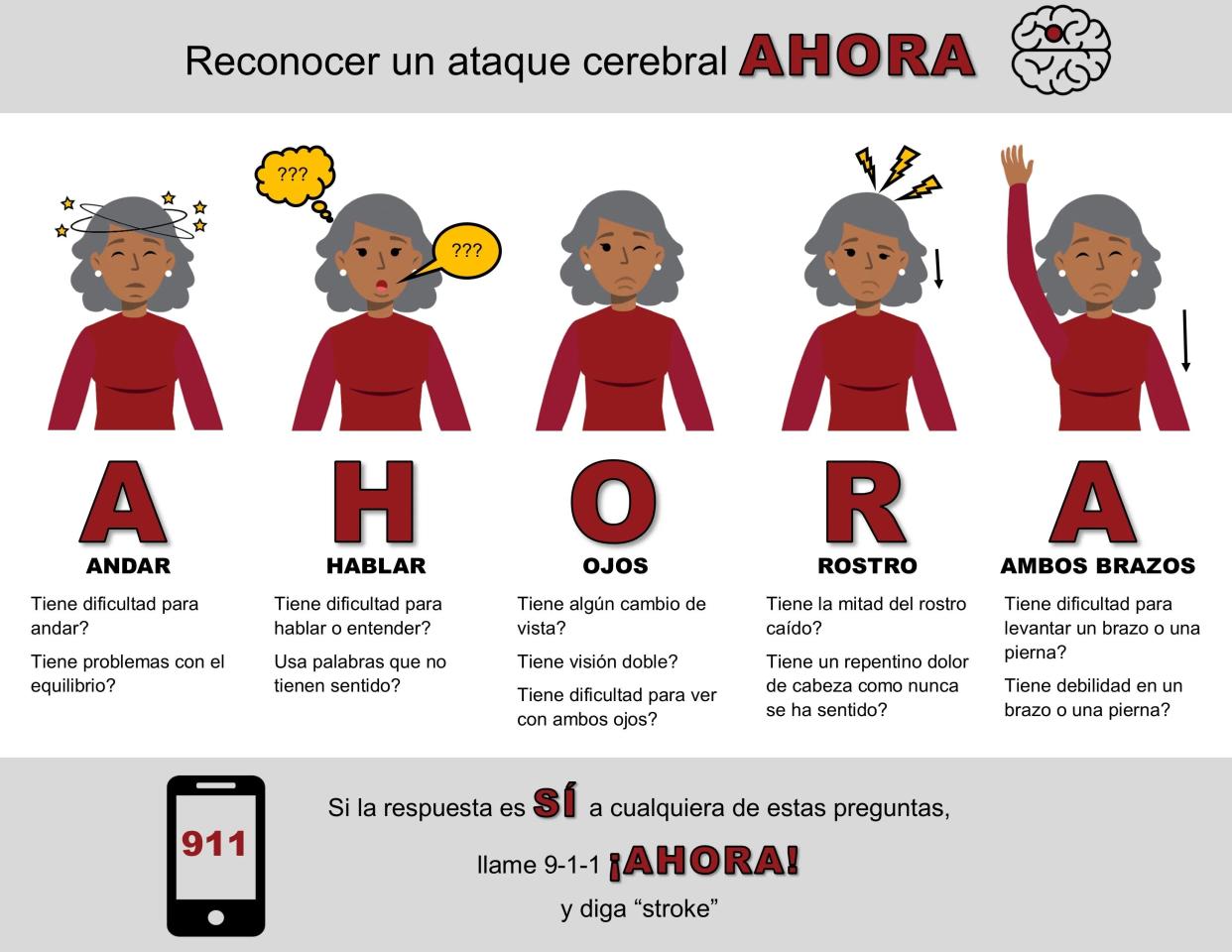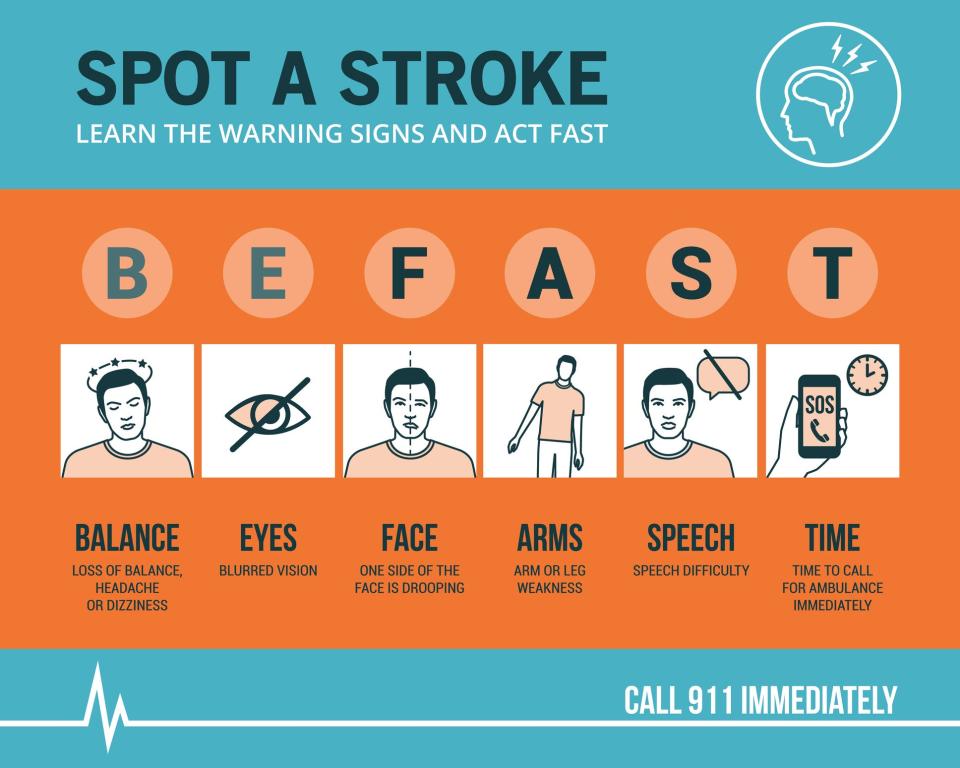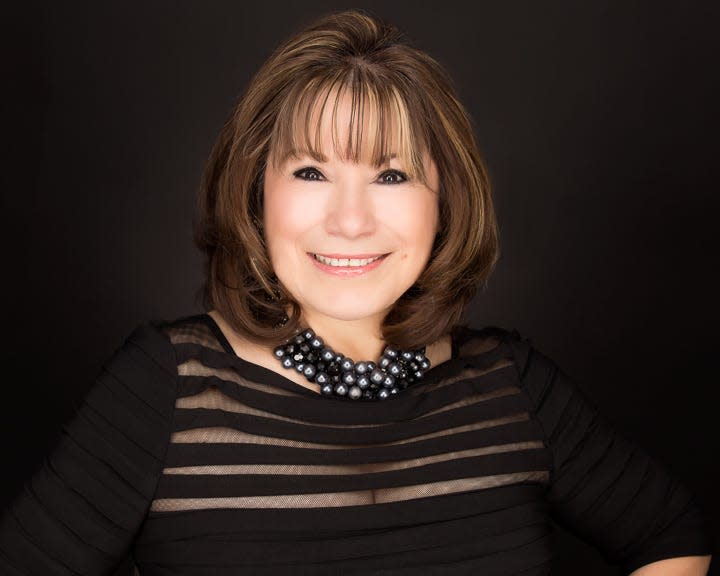AHORA: An Austinite's mission to create a Spanish memory aid for stroke detection

Stroke is the fifth-leading cause of death in the United States, but among the Hispanic population, it's actually No. 3, according to the American Heart Association.
While public education campaigns in the past decade have increased our knowledge of stroke symptoms and what to do if we suspect someone is having a stroke, a 2017 study found that 71.3% of non-Hispanic white participants had knowledge of stroke warning signs compared with 57.8% of the Hispanic participants. (The study found that 64% of African American participants had this knowledge.)
Marciela Wilson, a nurse and Ascension Seton's cardiovascular disease and stroke community outreach coordinator, has served on stroke prevention committees with the American Heart Association and the state, and she has spoken at national conferences about the importance of stroke prevention education in the Hispanic community.
Surviving a stroke: Marine brings combat, stroke recovery lessons into role as Lakeway hospital chaplain
She has received the Louis B. Russell Jr. Memorial Award American Heart Association and American Stroke Association for her work educating the Hispanic and black communities in Austin about stroke warning signs and prevention.
Growing up in Galveston, she would volunteer at Shriner Hospital for Children there, especially with kids who had traveled there from Spanish-speaking countries. She was their peer, and she spoke their language.
Before she became a nurse, she worked for the Mexican American Student Organization and then for LULAC, the League of United Latin American Citizens. She also did health education programs for Spanish-language TV and radio shows.
As the cardiovascular disease and stroke community outreach coordinator at Ascension Seton, she noted that the English-speaking population had a mnemonic device to help them look for the signs of a stroke: FAST, which stands for Face drooping, Arm weakness, Speech difficulty, Time to call 911.
Getting treated quickly: Dell Medical School at the University of Texas researches stroke medication tenecteplase
That has now been expanded to BE FAST: Balance (difficulty balancing or walking), Eyes (difficulty seeing out of one or both eyes), Face drooping, Arm weakness, Speech difficulty, Time to call 911.
For people who speak only or primarily Spanish, FAST or BE FAST isn't memorable. Wilson has been working on a Spanish mnemonic for years. At first, she developed RÁPIDO (which means quick): Rostro caído, Alteración del equilibrio, Pérdida de fuerza, Impedimento visual, Dificultad para hablar, Obtenga ayuda rápido (roughly translated to drooping face, balance disorder, loss of strength, visual impairment, slurred speech, get help fast).
That got promoted by the American Heart Association, but Wilson wasn't satisfied with it.

Stroke symptoms: What is aphasia? Explaining the condition that's affecting Bruce Willis and millions of other Americans
Now, Wilson says she is hoping stroke educators and groups such as the American Heart Association will adopt what she believes will be a simpler version: AHORA: Andar, Hablar, Ojos, Rostro, Ambos brazos. (walking, talking, eyes, face, both arms). Do they have difficulty with balance or walking, do they have trouble with speech or understanding language, do they have trouble seeing or double vision, does their face droop or do they have the worst headache in their lives, and do they have difficulty lifting their arms (or legs) and are both sides equal?
She presented AHORA in October at the EMS World Expo, a conference for emergency medical services directors. They have started using AHORA and sharing it with their employees to push it out to the public.
"Everyone uses (the word) ahora," Wilson said. "It has that meaning needing to do it now."
She and colleagues Remle Crowe, a research scientist in EMS data company ESO in Austin, and Dr. Paul Banerjee, a medical director at Polk County Fire Rescue in Florida, who worked on AHORA with Wilson are trying to reach stroke education providers in the Hispanic community. They've started a grassroots effort to share the AHORA mnemonic device with people in that community as well as doctors and clinics that treat them.

Educating the community: Preventing strokes in Austin’s Hispanic community is nurse’s passion
Wilson said she really wanted to get in something about the eyes and the face and having the worst headache ever, which are signs in particular of a hemorrhagic stroke. That type of stroke is more common in people who are Hispanic verses their non-Hispanic white counterparts.
"We put salt on everything. You eat watermelon, you eat it with salt. That increases blood pressure," Wilson said as one possible reason for that type of stroke when an artery suddenly starts bleeding into the brain.
During a stroke, getting immediate medical attention is important because many of the medications for strokes have a short window in which they can reverse or lessen the damage being caused by a stroke.
Wilson and Banerjee and colleagues tested AHORA in a study of 300 predominately Spanish speakers not in the medical community. The study participants found AHORA easy to understand, easy to teach and easy to implement. The study has been published in Neurology, the American Academy of Neurology's journal, and SVN, the Stroke and Vascular Neurology journal. It was funded by HCA Heathcare, of which St. David's hospitals are a part.
Wilson has been teaching AHORA at community gatherings, at companies with many Spanish-speaking employees and at predominately Spanish-speaking Austin Independent School District schools. She wants kids to be able to recognize the signs of stroke in their parents or grandparents.
Ascension Seton has developed an educational handout on AHORA to be given to patients at Ascension Seton hospitals.
"There's a lot more to do," Wilson said, but "they are all so happy to know there is something they can use to be able to recognize the symptoms of someone having a stroke."
AHORA
Andar
Tiene dificultad para caminar?
Tiene problemas con el equilibrio?
Do they have difficulty walking?
Do they have problems with balance?
Hablar
Tiene dificultad para hablar o entender?
Usa palabras que no tienen sentido?
Do they have difficulty speaking or understanding language?
Do they use words that don't make sense?
Ojos
Tiene algün cambio de vista?
Tiene visiön doble?
Tiene dificultad para ver con ambos ojos?
Do they have some change in vision?
Do they have double vision?
Do they have difficulty seeing with both eyes?
Rostro
Tiene la mitad del rostro caido?
Tiene un repentino dolor de cabeza como nunca se ha sentido?
Do they have one-sided facial droop?
Do they suddenly have the worst headache of their life?
Ambos Brazos
Tiene dificultad para levantar un brazo o una pierna?
Tiene debilidad en un brazo o una pierna?
Do they have difficulty lifting an arm or a leg?
Do they have weakness in an arm or a leg?
Stroke support groups
Ascension Seton's Spanish-speaking support group
Clinical Education Center at Brackenridge
Room C1.204 (1st Floor)
1400 N. Interstate 35
3-4 p.m. second Wednesday of the month
RSVP with Marcie Wilson, 512-324-8948
Find non-Spanish-speaking stroke support groups by ZIP code at stroke.org.
This article originally appeared on Austin American-Statesman: An Austinite aims to create a Spanish memory aide for stroke detection

